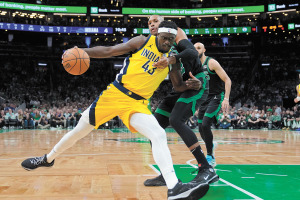Subscriber Benefit
As a subscriber you can listen to articles at work, in the car, or while you work out. Subscribe Now It was a familiar sight for veteran observers of the Pacers. The team awarded a max contract, and it was difficult to tell which stack was higher—the dollars or the words of praise.
It was a familiar sight for veteran observers of the Pacers. The team awarded a max contract, and it was difficult to tell which stack was higher—the dollars or the words of praise.
This time those words were for Pascal Siakam. The 30-year-old Swiss army knife of a player who quickly found a fit on a young, promising team following his acquisition in a January trade, signed a four-year deal for nearly $189 million, with incentives that can expand the pile.
It came as no surprise. In fact, it was a virtual necessity for the Pacers to execute the deal given the price they paid for Siakam: three first-round draft picks and three players in a move that thrust their rebuilding program into win-now mode. You don’t give up so many assets and then let the guy you got in return just walk away and forget the whole thing. That would be like borrowing money to buy a luxury car, driving it a few months, then leaving it on the side of the road for someone else to pick up.
The Pacers’ history related to max contracts warns of the danger of such commitments, but a press conference after such a major event is not the time for a history lesson. It’s the time for hyperbole.
Kevin Pritchard, the Pacers’ president of basketball operations, called Siakam “an incredible talent” and “totally unselfish,” then put a bow on the occasion by saying, “I can’t think of a bigger signing this organization has ever had.”
Pacers coach Rick Carlisle agreed, declaring it “easily the biggest free agent signing in the history of this franchise” and tagging Siakam as “a very, very special person and a very, very unique player.”
Whew! Timeout, please.
Those are awfully big words for a player who is, indeed, very good and crucial to the team’s future. But is he better than, say, Reggie Miller, Jermaine O’Neal or Paul George, all of whom re-signed with the Pacers during their careers? For that matter, is he better than Tyrese Haliburton, who signed a max extension last summer?

One has to assume Pritchard and Carlisle put Siakam in the category of a free agent coming from elsewhere rather than within. It’s true, Siakam wasn’t entrenched with the Pacers or Indianapolis after playing just 41 regular-season games and 17 playoff games following the trade. It was telling that he mistakenly thanked the Raptors rather than the Pacers at Monday’s press conference, a slip of the tongue he quickly corrected. It was forgivable. After all, he played 7-1/2 seasons in Toronto, one of which ended with a championship. Old habits die hard, regardless of the size of the contract.
Former max contracts
However you categorize Siakam, signing him was hugely significant for the Pacers, especially if he can live up to his promise to improve despite having crossed the threshold of 30.
“I want to be the best version of myself,” he said. “There are so many layers to my game that I can improve.” He also talked about wanting to import the championship mindset he experienced in Toronto to the Pacers.
Noble causes, to be sure, and Pacers fans should be intrigued, even excited. But they also can be forgiven for hints of skepticism given what happened to the previous players who were signed to max or max-vicinity contracts amid great hype.
Jalen Rose signed a seven-year, $93 million deal in 2000. He was 27 years old at the time and had been the leading regular-season scorer on what still is the only Pacers team to reach the NBA Finals. With Miller gracefully aging, it felt like the beginning of a new era—for him and the franchise.
“I never entertained the thought of not only talking to another team but playing for another team,” Rose said via a prepared statement. “My head and heart the entire time was to be an Indiana Pacer.”
That rosy scenario lasted but a season and a half. Rose quickly became an outdated misfit amid the emergence of younger players such as O’Neal, Al Harrington and Jonathan Bender and was traded to Chicago in February 2002. He wound up playing for three more teams after the Bulls.
O’Neal signed a seven-year, $127 million contract in 2003. A press conference was conducted in the Gainbridge Fieldhouse lobby with team President Larry Bird and soon-to-be-fired coach Isiah Thomas flanking him at the head table.
O’Neal, Bird said then, is “the cornerstone of the franchise. We’re going to try to build this team around him.”
O’Neal, 24 at the time, talked like a cornerstone, too.
“My goals are still the same,” he said. “Put my team at another level. Come back better, bigger and stronger, both mentally and physically, and be prepared to go to battle for 48 minutes every night.”
O’Neal, alas, was traded to Toronto in 2008. His production was starting to fade amid injuries, and the Pacers had been forced into a rebuilding mode that didn’t jibe with O’Neal’s timeline.
Paul George signed a five-year deal worth more than $90 million in 2014 after the Pacers had made a second consecutive trip to the conference finals. He was just 23, on track to becoming one of the greatest players in franchise history, with plenty of time to improve further.
“I feel I’m nowhere close to being the player I want to be,” George said at another press conference in the fieldhouse lobby. “Every year, I take a jump closer to where I want to be. Being 23, it’s the start of where I want to be as a player and person.”
By this time, Bird, back for a second term as team president, was well aware of the franchise’s history with max contracts. “I know we’ve had some in the past that didn’t really work out,” he said. “This kid’s different. He’s really different. Every time he speaks, you know he’s telling the truth, because you’ve heard him say it over and over.
“Before it’s all said and done, he can be on a level playing field with Reggie,” Bird added.
Perhaps he has been, but not with the Pacers. Unlike Rose and O’Neal, who were traded against their wishes, George asked to be traded in the summer of 2017. The Pacers had lapsed into a rebuild, partly because of the broken leg George suffered in the Olympic trials, and he didn’t want to be part of it. He’s still going strong at age 33 but will play for his third post-Pacer team next season in Philadelphia.
The max contracts of Haliburton (about $260 million over five years) and Siakam add perspective to Miller’s career, most of which was played before maximum salaries were instituted in 1999. He signed a new contract in 2000 that paid $35 million over three years and then another in 2003 that paid $16.5 million for the final two, although the payments were spread out over three.
Bottom line, Miller was paid a reported $104.5 million over his 18-season career. That’s nearly half of what Siakam will receive over the next four seasons alone. The yawning gap between the two is simply a reflection of the NBA’s worldwide popularity and the income it generates.
Broader perspective
Rose, O’Neal, George and Siakam have plenty in common beyond Pacer windfalls. All won the NBA’s Most Improved Player award early in their careers. All no doubt assumed they would finish their career with the franchise with which they won that award, or at least play several more seasons with it. But all were eventually broadsided by the harsh realities of NBA life. It’s difficult for both sides to remain happy when a player’s salary hits the roof. It comes with matching expectations.
It would be easy to declare the contracts given to Rose, O’Neal and George mistakes, gambles that didn’t pay off. But that’s not the complete picture.
Rose was part of a trade that brought Ron Artest, Brad Miller, Ron Mercer and Kevin Ollie to the Pacers. Artest and Miller became all-stars here, something Rose never achieved in his career, and the Pacers improved significantly because of that deal.
Four contributing players came to the Pacers when O’Neal was sent to Toronto. One of them, Roy Hibbert, became a two-time all-star for the Pacers. O’Neal never made an all-star team with any of the five teams for whom he played after the trade.
The forced trade of George to Oklahoma City brought back Domantas Sabonis and Victor Oladipo, both of whom became two-time all-star selections with the Pacers. George has been selected to five all-star teams in the seven seasons since leaving Indianapolis—injuries intervened in the other two—but has not produced as much as the assets he brought. Oladipo was the face of the Pacers franchise for a couple of seasons until injuries ruined his career. Sabonis became one of the NBA’s elite centers, and when it became obvious the Pacers needed a shakeup, he was sent to Sacramento in a trade featuring Haliburton.
Both are the respective foundations of their teams today.
Fact is, a star player on a major contract remains an asset, even if he underperforms his salary. There’s usually a team out there somewhere willing to give that player another chance and hope for the best. The Pacers won all three of the trades involving Rose, O’Neal and George.
Awarding a max contract also sends a statement, both to the team and to the rest of the league, that a franchise is willing to reward its star players. “Why would other players want to come to your franchise if you don’t do it?” the Pacers’ former roster architect Donnie Walsh asked.
Siakam appears more likely than the others to remain a Pacer throughout his contract, despite history’s red flags. Given the Pacers’ youth and success of the past season, he’s not likely to be caught up in a rebuild as O’Neal and George were. He also appears to be in sync physically and emotionally with the rest of the roster despite his advanced age and is less likely than Rose to become poorly cast.
Hyperbole aside, the Pacers simply had to stay wedded to Siakam, at any price. Maybe this time there won’t be a divorce.•
__________
Montieth, an Indianapolis native, is a longtime newspaper reporter and freelance writer. He is the author of three books: “Passion Play: Coach Gene Keady and the Purdue Boilermakers,” “Reborn: The Pacers and the Return of Pro Basketball to Indianapolis,” and “Extra Innings: My Life in Baseball,” with former Indianapolis Indians President Max Schumacher.
Please enable JavaScript to view this content.
